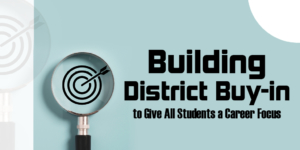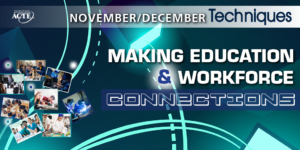A career focus for all students
Often, high schools still sort students into one of three silos — college, workplace and everyone else — and then assume nature will somehow take its course. Everyone with a high school diploma will find their way to a fruitful career, right? Not exactly.
CTE educators must help more students pursue and earn advanced credentials or degrees in high-wage career fields. Positive outcomes will not happen automatically. Students need well-designed high schools that engage them and their families in thoughtful decision-making about career pathway-oriented programs of study.
To give all students a career focus, rally education stakeholders.
District leaders must obtain buy-in from district staff, school and teacher leaders, and community stakeholders. This work involves creating shared ownership of both the problem and the proposed solutions. It’s important that all stakeholders, internal and external, begin to recognize the gaps and how to close them.
District-level study groups can be an effective tool for building buy-in.
The district assessment study group identifies the gaps between current practices and the bold goals. An honest appraisal by such a team is a good way to raise awareness among key groups about the misalignment between current student readiness levels and employer expectations. It is essential for the success of all students, but particularly for diverse students, to conduct an unbiased assessment.
The district career pathway study group analyzes gaps between the career pathway design features and current school practices. And they make recommendations for closing the gaps. The district high school organization and scheduling study group analyzes best practices for increasing student motivation through connected academic and career studies. This group presents options and guiding principles for organizing the high school around students’ career interests while remaining connected to a college-ready core. They collaborate to develop a scheduling system that allows academic and career pathway teachers to co-plan for shared cohorts of students.
The district strategic planning study group helps ensure communication and coordination across all groups. Composed of representatives from the other study groups, this group considers all data and recommendations and develops a comprehensive district plan. The results will include a framework of best practices, a communication plan for internal and external audiences, a process for supporting continuous improvement at the secondary and postsecondary levels, and guidance on how to support individual schools in designing their own customized improvement plans. We observed the most-improved schools to be those that greatly increased access to high-wage, high-demand career pathways.
High-quality CTE programs address the full range of students’ interests and aptitudes. They connect to work site experiences and postsecondary studies, and offer rigorous academics.
With study groups established, the next step involves ensuring all stakeholders agree on certain baseline data. Graduate 95% of students who enter ninth grade, with 90% graduating college-ready, career-ready or both. Further, the study groups should agree on how to evaluate the current readiness overall and across specific student subgroups (e.g., by gender, race/ethnicity, socioeconomic status, disability).
The groups begin by assessing the percentage of district students entering the ninth grade who are ready to succeed in college preparatory academic courses and challenging career pathway courses. Moving on through the transition into high school, they examine the success of current and previous ninth grade students. How many ninth graders earned enough credits to be classified as sophomores? And what percent succeeded in completing a college-ready core? Of particular importance to track are literacy and mathematics achievement.
Set bold goals for postsecondary achievement in CTE.
Once gaps are identified, the study groups can consider changes regarding how students in grades six through nine are taught, what is expected of them, and which groups of students need greater assistance to complete higher-level academic courses. Remember that, ultimately, the goal is to ensure that 95% of students progress into rigorous, grade-level courses on time. The study groups’ examination of students’ success should continue as they approach graduation and after.
Key metrics, developed in collaboration with leaders from industry and postsecondary institutions, may include:
- Graduation rates compared with the 95% goal
- Percentage of graduates who earned an industry-recognized credential or degree by age 25
- Percentage of graduates who met math and literacy indicators
- Rate of students entering college who completed a college-ready core
Consideration and use of these data can help district leaders convince stakeholders of the need to expand access. Too often, the process that places students in rigorous academic environments works not on merit or aptitude. But on the basis of socioeconomic levels. Examining districtwide data for all students, and within student subgroups, will help determine if academic placement practices need to be revised.
Stakeholder support sustains high-quality CTE.
Postsecondary leaders can articulate academic knowledge and skills, and other attributes needed by students to earn a credential or degree. They can also identify reasons why students may struggle with the transition to postsecondary education. Business and industry leaders can discuss the changing workplace requirements and share, specifically, what skills they need most. Including both industry and postsecondary representatives on the study teams can help validate the need to provide accelerated learning experiences as well as higher levels of support, to help students succeed.
Family members, too, can play a valuable role in the district study groups. “One lesson I learned was to engage my faculty with [students’ family members],” said Stephanie Johnson, deputy superintendent at the Georgia Department of Education, “along with business and community leaders who all want the same quality of education for disenfranchised students that the school is providing to high- performing students.
“As educators listen to these voices, they begin to see the need to revise the curriculum and implement more challenging learning experiences for all groups of students. This outside support for change becomes their rationale for creating a meaningful and higher-level learning culture.”
In Tomorrow’s High School, Gene Bottoms offers proven, practical solutions to make high schools a rich and rewarding experience for all students, whatever their college and career goals may be. Give all students a career focus! Educators, consider how a book study can foster professional growth — and help save on the price. Contact the author for more details.
Gene Bottoms is a school improvement leader emeritus. He is a former senior vice president of the Southern Regional Education Board and a former executive director of ACTE.





